The Layout of a Novel
By Nat Russo
A few weeks ago, as I began storyboarding the sequel to my novel, Necromancer Awakening (my bestselling dark fantasy, now available on Amazon) I came across the Story Forge Cards website, watched the video tutorials, and couldn’t wait to give them a try.
After using them for a couple of weeks, and trying each of the various “spreads” (patterns/layouts of cards), I’d like to show you the product and share my experience. I’ll walk you through a “Character Backstory” spread and give you my opinion on how useful I found the cards.
The idea behind Story Forge Cards is not unlike Tarot cards. You shuffle the deck, lay the cards out in a pattern known as a “spread”, then interpret the cards based on their individual positions. For example, the first card you lay down in a “Character Backstory” spread represents your character’s mother. Second card the father, and so on (much more detail below, I promise).
This attracted me more than any other set of story-building cards, and I’ll get into specific reasons below. But I remained skeptical. I was worried that I’d allow some randomization process to replace my creativity. I’m not big on rolling the dice when it comes to my stories. But I knew I couldn’t simply dismiss this tool without giving it a try.
The booklet is printed in a clearly readable font and goes into detailed descriptions of each of the five “suits” in the deck. The last half of the booklet is dedicated to each of the stock spreads available. The spreads available to you out of the box are:
•Once Upon a Time
•A spread for getting a story rolling
•Character Backstory
•Character “Quick Pick”
•A great spread for determining characteristics of a minor character.
•Hero’s Journey
•Yes…the entire hero’s journey. An amazing 22-card spread.
•The “Train Crash”
•A spread that sets two characters on a collision course.
•Film Noir
•The Love Story
•The Action Movie
•The Crossroads
•A spread that works through a moral dilemma.
While the booklet serves its purpose wonderfully, the quality of the cards is outstanding. They are printed on high quality card stock in vivid colors. Quite frankly, they’re a pleasure to hold in your hands. They’re larger than average playing cards, lending to the sensation that you’re holding something substantial.
Each card falls into one of five “suits”. The suits are as follows:
•Destiny
•Wealth
•Will
•Emotion
•Identity
Each card contains two abstract concepts, one at the top of the card and the other at the bottom. The bottom concept is “upside down”, so if you don’t like the one on top, just rotate the card 180-degrees and see if you like the other concept better.
In addition to these cards, each suit contains two “blank” cards, allowing you to customize your deck according to your specific needs. For example, I added elements from my own milieu to make them feel as if they fit into my fictional universe organically. The instructions say you can use a Sharpie or other marker to fill in the blank cards, but I opted for labels with a light adhesive. Time will tell if this works or not, but I’m hoping to be able to change them in the future without damaging the cards.
Let’s get to what you’re all waiting for: how to use the cards. Once I started using them, I found them so incredibly helpful that I wanted to use them for everything! I had to reign myself in. I ran a couple of Character Background spreads on characters in my series, but if I showed them to you they’d reveal too many spoilers. So I created another character for this article to take you through a sample spread.
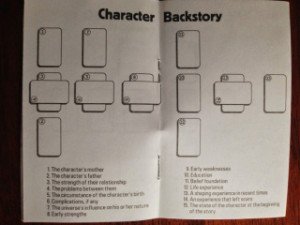
Our sample character is “Jake”, and he’s a “Druid”. I know nothing about him whatsoever other than his name and profession. So I open the Story Forge Cards manual and flip to the Character Background spread. This is what I find:
Looks like fun! So I shuffle the cards and start laying the cards out according to the pattern in the manual.
I pull card 1, which, as you can see from the booklet, represents the character’s mother.
CARD 1
Immediately I feel the creative spark. The “heart” means this card is from the “Emotion” suit. I open up my notebook and start writing:
Jake’s mother was raised to believe people are destined for marriage. Nature created male and female to be in perfect harmony, and this harmony is perfectly expressed through marriage.
[Note: All of the notes I’ve written on each specific card are transcribed in raw form directly from my notebook. They’re not edited so you can get a feel for how they spilled out as I saw the cards for the first time.]
Not a bad start. But as you’ll see, the cards shine once you can draw connections between them. Let’s move on to Card 2, which represents Jake’s father:
CARD 2
This purple card belongs to the “Destiny” suit. The “escape from damnation” part really caught my eye, so I wrote the following:
Jake’s father was primarily a hedonist. The order [of Druids] accused him of being out of balance and threatened to expel him if he didn’t turn his life around. He decided to get married, and the order gave him a second chance.
Right away there’s conflict. On the one hand, you have a woman who lives for monogamy, and she winds up married to a reformed hedonist. Potential recipe for disaster, if you ask me.
Card 3 represents the strength of the mother and father’s relationship:
CARD 3
Yellow cards are from the “Wealth” suit. While wealth can be taken literally, that’s not necessary. I scratched my head for a moment and began writing:
Through their mutual love of the druidic religion, and their common activities of serving the poor and needy, their relationship blossomed into love.
So we have two individuals with fundamentally different backgrounds finding common ground through their church. Let’s pull card 4, which represents the source of the problems between them.
CARD 4
The green cards are from the “Identity” suit. Now this is getting interesting. Something about “disguise” is the source of their problems. Knowing the father’s background from card 2, I write the following:
But Jake’s father couldn’t help slipping back into his old womanizing ways. He developed elaborate ways to conceal this from his wife, but she was always suspicious.
I like it. Disguise, in and of itself, may not mean much. But when I made the connection between this “problem” card and the father’s background card, you can see how it sparked an interesting source of tension. Tension that may have far-reaching implications. But we don’t know about that yet. We’ll have to keep drawing. Let’s move on to card 5, which represents the circumstances surrounding our main character’s (Jake’s) birth.
CARD 5
Yowza! Holy (or unholy) moly! My creative mind went on overdrive!
While his mother was giving birth to him, Jake’s father was in the midst of another affair and chose sex with his mistress over attending the birth. Having been suspicious of him for some time, and this being the straw that broke the camel’s back, the Order’s leader sought Jake’s father out and caught him in the act. This was too much, and Jake’s father was expelled from the Order. Not long after, he took his own life.
Again, it seems to be all about the connections between cards. I had been consciously or subconsciously developing the theme of Jake’s dad being unfaithful to Jake’s mom. This idea had already been planted, and the cards helped me to develop it further.
I move on to card 6, which deals with any complications with the birth.
CARD 6
I decided to take a loose interpretation of “complications” and just focus on the fear:
The Order had provided food and shelter to Jake’s family, but they withdrew this protection when the evil of the father was revealed. Jake’s mother had nowhere to go, and she was constantly afraid she wouldn’t be able to provide.
Moving on to card 7, which represents the universe’s influence on the character’s nature:
CARD 7
An interesting card, and it seems to fit in with our “Druid” theme. This is meant to be an influence on Jake, so:
A druid of the Order remained friends with Jake’s mother, and in many ways he was a second father to Jake. He was a positive influence on Jake, instilling the Druidic moral code in a way that Jake connected with.
An interesting turn. I almost would have expected Jake to turn his back on the druids as they turned their backs on Jake’s mom. But because of a positive influence, it almost seems as if he understands and perhaps even admires them.
Card 8 represents Jake’s early strengths:
CARD 8
This is the first blue card we’ve seen. Blue represents the “Will” suit, which often involves conscious decision:
Jake remembered the conflict between his mother and father and swore he’d never live like that. Instead, the more he devoted himself to Druidic principles, the more peaceful his life became.
Clearly Jake is gravitating towards the Druidic order himself.
Let’s take a look at card 9, which represents Jake’s early weaknesses:
CARD 9
Very interesting. Even though Jake seems to be putting the shame of his father behind him, and is actively applying druidic principals to his life, something is holding him back:
No matter how peaceful his life became, he believed he was destined to turn out just like his father. No one could tell him otherwise, regardless of evidence to the contrary.
Obviously the sins of the father have impacted the life of the son!
Card 10 represents the character’s education. I drew this card:
REJECTED CARD 10
Amnesia as an education? This was the first one that didn’t make much sense to me. No matter how hard I scratched my head, this one just didn’t gel. So, using the advice from the manual, I simply drew another card! (Yes…this is perfectly legal. Remember, the cards are the writer’s tool, not the writer.) On my second draw I pulled this:
CARD 10
Ok, this I can work with. Again I felt the spark of imagination (which is, after all, what this is all about. That’s the very purpose of the cards!). Alliance…let’s think. Given all we already know about the character:
The Druidic Order saw how devoted to their principles he was, so they decided to induct him into the Order. They trained him for years until eventually he became a full-fledged Druid.
The next card, card 11, represents Jake’s belief foundation:
CARD 11
This seems to map to what we already seem to know about Jake and his “tranquil” ways:
Jake took to heart the principle that a person should seek no more than they are provided by the universe. A person should be happy with his/her place in life. Discontentment leads to tragedy, as it did with his father. His father couldn’t be content with a single woman in his life, and this led to his downfall.
Again we see the connections are all-important. Without a philandering father and a druid mentor, Jake may have turned out to be anything but content.
Card 12 represents Jake’s life experience. Let’s see what we draw:
REJECTED CARD 12
This is very interesting. And dangerous. I don’t want Jake to turn out anything like his father, no matter what the universe has decided to hand me. So I’m going to step in, as the writer, and say “no” to fate. I draw again:
CARD 12
A little better, and fits the theme we’re establishing:
Jake lived his life as a man of faith. He was a devout druid that rose in his order and became a mentor to younger druids. He discovered that faith was powerful, often giving him power over situations that lesser druids couldn’t control.
Card 13 represents a shaping experience.
CARD 13
I’m going to spare you some additional details, because you’ve already seen how it’s possible to simply draw another card if you don’t like the first one you get. It’s also acceptable to flip a card 180-degrees if you prefer the upside-down concept. Suffice it to say I did a little of both (including swapping card positions) for the last 3 cards. Let’s look at Safety and see what I came up with:
As long as he focused on maintaining balance in his life, and followed the precepts of the Druidic Order, he was well provided for and wanted for nothing.
Card 14 represents an experience that left scars.
CARD 14
I think I can see how Deception would leave scars! So how can we have Deception tie in with earlier themes? This is where my own writer’s mind is going to take over once again. I tend to gravitate towards subjects involving abuse of religious authority, and also religious hypocrisy in general:
While out on the business of the order, Jake discovers the Order’s leader living two lives. The leader has a second family that no one knows about, and he was using the Order’s resources to care for them.
And now we’re finally here: card 15. The final card. This card represents the state of the character when the real story begins.
CARD 15
It definitely fits with where I was going with Jake. He’s a druid. I don’t know about you, but when I conjure an image of a fantasy druid, I see a peaceful, nature-loving person:
With the leader expelled, balance is restored. Jake rises to take leadership of the Order, and the Order enters a period of unprecedented prosperity.
Without even having a plot for this character, I can already see what might happen. I bet it has something to do with upsetting that “unprecedented prosperity”! After all…we can’t have “happy people in happy land” or we don’t have a story.
And that’s where I ended up.
I can’t emphasize enough how much this tool can enhance the creative process. Not only are the out-of-the-box card spreads wonderful, but it is also quite possible (and easy!) to create your own custom spreads.
And If you’re afraid these cards might hijack your creativity (as I initially was), set that fear aside. Utilizing the cards to create background story for my characters allowed me to not only mine what I already knew about them, but to add even more depth than I had thought possible.


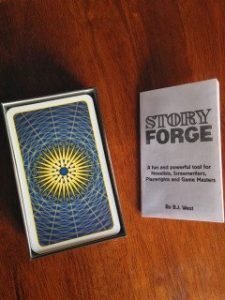

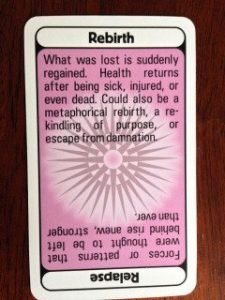







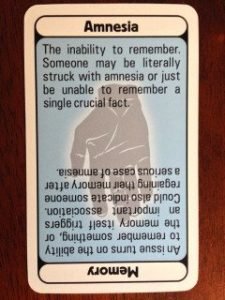
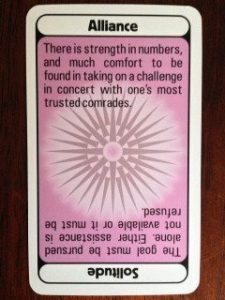

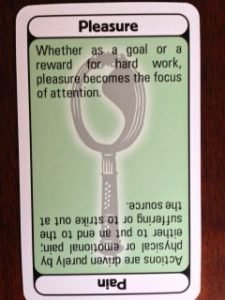

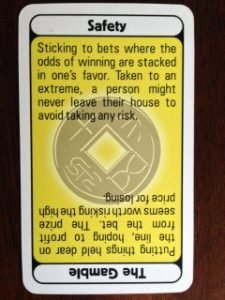
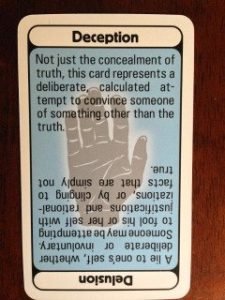
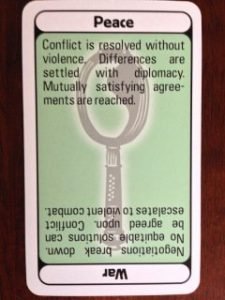
This is an incredible tool for creativity